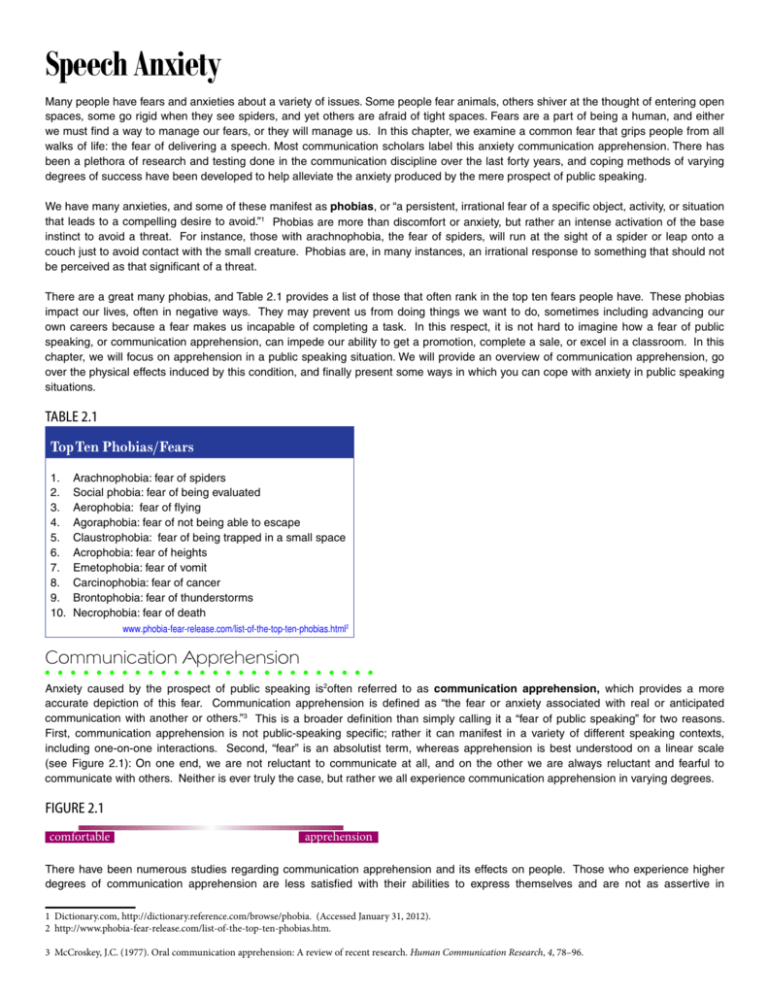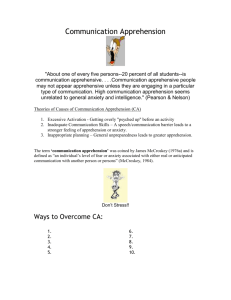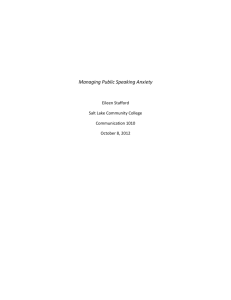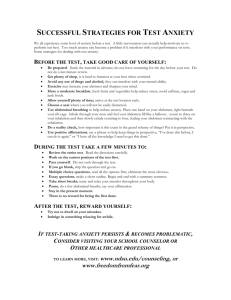Speech Anxiety - Fountainhead Press
advertisement

Speech Anxiety Many people have fears and anxieties about a variety of issues. Some people fear animals, others shiver at the thought of entering open spaces, some go rigid when they see spiders, and yet others are afraid of tight spaces. Fears are a part of being a human, and either we must find a way to manage our fears, or they will manage us. In this chapter, we examine a common fear that grips people from all walks of life: the fear of delivering a speech. Most communication scholars label this anxiety communication apprehension. There has been a plethora of research and testing done in the communication discipline over the last forty years, and coping methods of varying degrees of success have been developed to help alleviate the anxiety produced by the mere prospect of public speaking. We have many anxieties, and some of these manifest as phobias, or “a persistent, irrational fear of a specific object, activity, or situation that leads to a compelling desire to avoid.”1 Phobias are more than discomfort or anxiety, but rather an intense activation of the base instinct to avoid a threat. For instance, those with arachnophobia, the fear of spiders, will run at the sight of a spider or leap onto a couch just to avoid contact with the small creature. Phobias are, in many instances, an irrational response to something that should not be perceived as that significant of a threat. There are a great many phobias, and Table 2.1 provides a list of those that often rank in the top ten fears people have. These phobias impact our lives, often in negative ways. They may prevent us from doing things we want to do, sometimes including advancing our own careers because a fear makes us incapable of completing a task. In this respect, it is not hard to imagine how a fear of public speaking, or communication apprehension, can impede our ability to get a promotion, complete a sale, or excel in a classroom. In this chapter, we will focus on apprehension in a public speaking situation. We will provide an overview of communication apprehension, go over the physical effects induced by this condition, and finally present some ways in which you can cope with anxiety in public speaking situations. Table 2.1 Top Ten Phobias/Fears 1. 2. 3. 4. 5. 6. 7. 8. 9. 10. Arachnophobia: fear of spiders Social phobia: fear of being evaluated Aerophobia: fear of flying Agoraphobia: fear of not being able to escape Claustrophobia: fear of being trapped in a small space Acrophobia: fear of heights Emetophobia: fear of vomit Carcinophobia: fear of cancer Brontophobia: fear of thunderstorms Necrophobia: fear of death www.phobia-fear-release.com/list-of-the-top-ten-phobias.html2 Communication Apprehension Anxiety caused by the prospect of public speaking is2often referred to as communication apprehension, which provides a more accurate depiction of this fear. Communication apprehension is defined as “the fear or anxiety associated with real or anticipated communication with another or others.”3 This is a broader definition than simply calling it a “fear of public speaking” for two reasons. First, communication apprehension is not public-speaking specific; rather it can manifest in a variety of different speaking contexts, including one-on-one interactions. Second, “fear” is an absolutist term, whereas apprehension is best understood on a linear scale (see Figure 2.1): On one end, we are not reluctant to communicate at all, and on the other we are always reluctant and fearful to communicate with others. Neither is ever truly the case, but rather we all experience communication apprehension in varying degrees. Figure 2.1 comfortable apprehension There have been numerous studies regarding communication apprehension and its effects on people. Those who experience higher degrees of communication apprehension are less satisfied with their abilities to express themselves and are not as assertive in 1 Dictionary.com, http://dictionary.reference.com/browse/phobia. (Accessed January 31, 2012). 2 http://www.phobia-fear-release.com/list-of-the-top-ten-phobias.htm. 3 McCroskey, J.C. (1977). Oral communication apprehension: A review of recent research. Human Communication Research, 4, 78–96. interactions with others.4 One would think that as a result of this, those with high communication apprehension would begin working on presentations in advance, but the opposite is actually typically true. People with high communication apprehension often procrastinate because they do not believe they will succeed.5 This is an example of the self-fulfilling prophecy, which is convincing yourself that something is going to happen before it does, thus leading to the occurrence of what you originally expected. The self-fulfilling prophecy can be negative or positive. If you convince yourself that you will fail a calculus examination, then, with that mind-set, you likely will. However, convincing yourself that you will do well in an upcoming soccer game, although certainly not a guarantee, will enhance your chances of success. These preconceived notions have a powerful effect on people, and later we will suggest some ways to help ensure that you have a positive vision of delivering your speech. One important step in understanding your level of communication apprehension is identifying to what degree you are anxious about interacting with others. Professor James McCroskey developed a survey instrument that helps individuals measure their level of communication apprehension. The PRCA-24, the latest version of this scale, can be very helpful in identifying your own degree of communication apprehension. See the sample of the PRCA-24 report on the next page. Learning about yourself is just one step in helping you manage communication apprehension; you must also understand what the fear physically does to you. Many people believe they know the answer to this, but what we are about to tell you may surprise you and help you find ways to overcome your fear. Physical Effects of Communication Apprehension Anxieties begin in the brain with thoughts and perceptions about things around us that we believe threaten us. Once they emerge in our thoughts, anxieties then physically manifest themselves, and to some people this is more distressing than the mental duress. In fact, the physical dimensions of anxiety are what we naturally focus on when we feel fear or trepidation toward some external stimulus. Suppose you are batting in a fast pitch softball game with two outs in the bottom of the ninth inning, the bases are loaded, there are two outs, and your team is down by three runs. You go to the batter’s box, your stomach is churning, you are perspiring, and there are butterflies in your stomach. You are aware of all these physiological feelings, but how much do the fans in the stands actually see? The answer is that they see very little, and often none, of your anxiety—even the physical effects. The same principle is true of giving a speech to a live audience. You may have the same feelings as the batter, but the audience sees little, if any, of the effects of the anxiety. For speakers who are self-conscious about their appearance while delivering the speech, this should afford some comfort because the bottom line is this: no one sees your anxiety or apprehension. To further illustrate the invisibility of anxiety let’s take a look at some of the common physical reactions that occur when we are anxious or stressed. One physical effect of anxiety is a rise in blood pressure. This is not necessarily a bad thing, as it can give you energy, nor is it anything an audience will notice and correctly attribute to fear on your part. Higher blood pressure in these situations sends signals to the brain that it needs to pay heightened attention to your surroundings—not a bad thing. Blood pressure is also something that is internal, and thus not likely to be noticed by people around you. Of course, it can cause your face to flush red, but this can be explained away as a result of the heat in a room, not your anxiety over a public speaking situation. In addition to higher blood pressure, some people also experience shortness of breath when they are anxious, and in speaking situations this can negatively affect the delivery of the speech. Shortness of breath, however, can also be explained by myriad other causes. Perhaps you are coming down with or recovering from a cold; you may suffer from asthma; there may be something in the air to which you are allergic. All of these are plausible explanations to which other people, or you, can attribute the shortness of breath. A third physical effect of stress and anxiety is called galvanic skin tightening. Your skin, like any organ, responds to stimuli and stress. Specifically, your skin tightens when you are anxious, nervous, or stressed. Obviously we ourselves do not even feel this happening, so it stands to reason the audience cannot even see it either. Interestingly enough, this particular response to anxiety is used as an indicator of deception on lie detector tests and is virtually impossible to fake. For our purposes, though, it is enough to know this physical effect of fear is not noticeable to the human eye—it is related to one of the most common physical reactions to anxiety, though, which we will discuss next. 4 Ayres, J., & Heuett, B. L. (1997). The relationship between visual imagery and public speaking apprehension. Communication Reports (1), 87–94. 5 Behnke, R., & Sawyer, C. (1999). Public speaking procrastination as a correlate of public speaking communication apprehension and self-perceived public speaking competence. Communication Research Reports, 40–47. The tightening of our skin tends to make us sweat as well, and perspiration is the final physical manifestation of anxiety we will discuss. Apprehension can cause us to perspire, but that doesn’t mean the people around us believe we sweat because of anxiety; there are multiple factors that may make us perspire. Many other variables that play a role in our sweating are part of our external environment, such as sunshine, a room that has elevated temperature, or a very crowded, small conference room. You also may have just concluded a workout and taken a hot shower, which can also make you sweat for a period of time following that activity. These variables are all outside speakers’ power to change, but may make them perspire nonetheless. In these situations, it is important to understand two things: the audience does not automatically correlate perspiration with fear, and more importantly, the audience is in the same condition as you and thus probably dealing with the same physical responses as you. There is no doubt that stress and anxiety, particularly in public speaking settings, can elicit physical reactions from each of us, from heightened blood pressure to perspiration. There is also no doubt that audiences do not automatically correlate the physical responses to the anxiety we may be feeling—that is unless we tell them the two are related! The more you focus on your physical responses, the more likely you are to experience even more anxiety. It is far better to just let the body do what it does, and not focus on it. After all, if you pay attention to your physical response to anxiety, your audience will do so as well. So, we now know that everyone experiences communication apprehension to some degree or another, and that our bodies react to the stress produced by anxiety in these situations in ways that are virtually invisible to the audience. Both of these facts should provide some comfort when you prepare a presentation, but there is more we can do to manage our anxiety than simply understanding the situation. In the final section of this chapter, we will go over a few things to assist you with managing both the mental and physical manifestations of anxiety. Combatting Communication Apprehension Our bodies’ reactions to stress may be outside our direct control, but there are several ways we can mitigate the potential damage that anxiety can cause. Specifically, in this section we will provide several simple tips for preparing a presentation that will help reduce communication anxiety. Practice, Practice, and Practice We mentioned earlier that people with high communication apprehension are more likely to procrastinate preparing a speech, despite the fact they should be spending more time getting ready so they can overcome their fear. So, it stands to reason the first suggestion we have for coping with communication anxiety is to practice your presentation as much as possible for as long as you can. At first, practice giving the speech alone so that you become more comfortable with what you plan to say. Once you have a final version of your speech prepared and you have practiced it alone, add a mirror to the practice equation. Practicing in front of a mirror can increase your comfort and allow you to see what you look like when delivering the speech. Practicing in front of a mirror is not enough, though, as it does not accurately simulate the situation in which you will be presenting. So, after taking advantage of the mirror, add some actual people to create an audience. Make sure these are people you know and with whom you are comfortable, such as friends and family. Ask them for honest feedback, and make some adjustments. This practice regimen helps simulate the experience of delivering your remarks to an actual audience, but there is something else to try and simulate when practicing. We will cover practice more extensively in Chapter 19. In addition to an audience, whenever possible you should try to get a few practice sessions in the environment within which you will be speaking. If it’s a boardroom, then practice at a dining room or kitchen table; if it’s a large conference room, see if you can get access to it in advance; if it’s a classroom, try to go when there is not a class occupying the space. It is as important to become comfortable and practice within the environment in which you will speak, as it is to simulate the audience to whom you will speak. Practicing with both of these things in mind will help alleviate some apprehension about delivering your talk. Employ Relaxation Techniques Practicing remarks in advance is the best suggestion we can offer, but often times you will not be afforded much notice to give a presentation, thus limiting the amount you can feasibly practice. Such short-term presentations only serve to heighten our apprehension about public speaking, so they require more immediate methods for reducing stress and tension. One such method is to learn to use relaxation techniques before presentations. This is very useful in situations in which you have little time to prepare and practice, but also can be helpful when you have had time to practice. There are a variety of relaxation techniques that can help calm nerves, lower blood pressure, and help you focus before giving a talk. Some require a little more time than others, but all are helpful in a pinch. Simply taking a few minutes to stretch your back, shoulders, and legs will help unleash some pent up tension in your muscles and allow you to feel and look more comfortable in front of an audience. Remember, public speaking is a physical activity in much the same way jogging and weightlifting are, so it stands to reason we should prepare for giving speeches in a similar way to how we prepare for workouts. For some people with high communication apprehension, it might also be beneficial to engage in more structured and consistent stretching exercises. In these instances, joining a Yoga or Pilates class might help train you in more varied methods of relaxation and stretching. It also might provide the opportunity for you to go to a class before or even after a presentation to help reduce tension and relax. A third relaxation technique is deep breathing, and of all the relaxation techniques we have discussed this one takes the least amount of time. There is a lot to be said for closing your eyes and taking a few deep breaths before beginning a presentation. This helps improve the flow of oxygen in your blood, reduces blood pressure, and focuses your thoughts. There are various forms of deep breathing exercises in which you can engage, and all are helpful in reducing anxiety before speaking situations. Table 2.2 What Should I Eat Before I Give My Speech? Poor Choice Breakfast Lunch Snack Better Choice Sugary cereal and white toast with jam Oatmeal with fruit, nuts, and a glass of milk Pancakes or waffles with maple syrup Scrambled eggs and whole-wheat toast Fettuccini alfredo Grilled chicken with steamed vegetables and brown rice Large burger and fries Turkey, Swiss, lettuce, and tomato sandwich on whole grain bread Cookies or candy bar Fruit and yogurt Potato chips and energy drink String cheese and whole wheat crackers One final suggested relaxation technique, rather than a formal practice, is a simple guideline for any type of activity. It is imperative that when speaking you feel your best, and so you should always get a good night’s sleep before your presentation, and make sure you are not hungry. When it comes to sleep, you may feel the need to stay up late the night before a talk to practice as much as you can, but if this keeps you from being well rested the next day then the efforts will be counterproductive. In terms of food, be careful not to be hungry when you talk, but also not so full as to want to take a nap. Before you speak, have a nutritious meal that includes a healthy balance of complex carbohydrates, proteins, and fats that will be digested slowly, and try to avoid simple carbohydrates and refined sugars that will give you a burst of energy followed by a crash as your blood sugar levels spike and then fall quickly. You should also avoid eating heavy meals that might make you drowsy (see Table 2.2). Visualize Success Often, those with high communication apprehension envision giving a speech as a torturous experience and they see all the possible ways they can fail or make mistakes. Like the self-fulfilling prophecy, this often leads to that result, thus perpetuating the cycle of communication apprehension. No amount of practice or relaxation techniques can change the way we envision the speaking experience, so this third way to reduce anxiety aims to combat the negative mental picture we might have of delivering a presentation. The best time to visualize success is following a practice session; however, it works just about any time you want to do it. After you have practiced your speech a few times and feel more comfortable with it, get in a relaxed position, on either your bed, the sofa, or a recliner. One thing that is required is for you to be alone, with no distraction. Visualization requires concentration, and so it is important that you do not listen to music, watch television, e-mail, text, or use Facebook or Twitter when trying to do this. Close your eyes and see yourself giving the speech from beginning to end. Visualize your confidence, pride, and good delivery. Concentrate on visualizing what you have control over instead of focusing on audience reactions. Focusing on audience reactions might lead to a letdown if the visualized responses do not occur when you deliver the speech. Visualizing success can work, just like the self-fulfilling prophecy. Dialogue with the Audience One of the scariest aspects of public speaking is the perception that you speak to an audience of many people, all of whom are focused on you. One way to reduce the anxiety this situation creates is to change the way we understand the public speaking context. Instead of viewing it as a presentation to a large group, treat it like multiple simultaneous dialogues, or conversations. That is to say, instead of presenting to a class of thirty, you are holding thirty conversations at the same time. We all have conversations daily, and so this may help you reduce the anxiety that a group of people may induce. This dialogic approach can be extended as well if you want to create actual give-and-take with the audience. This can work, especially if the audience is small and well-mannered. It can be advisable to let audience members join in the discussion, but before making this decision, make sure you have a strong grasp of the makeup of your audience and their feelings toward you and the ideas you plan to advocate. One final word of caution regarding dialoguing with an audience: if someone asks a question to which you do not know the answer, be honest and tell the audience you do not know, but that you appreciate the question and will find out and get back to them if you can. Systematic Desensitization Each of the suggestions we have made thus far pertains to specific speech situations, and although applicable every time you deliver a speech, in isolation they can have little impact on your overall apprehension toward public speaking. This is where the approach called systematic desensitization comes in. Systematic desensitization is the process in which a person is slowly introduced to a fear and each time he or she overcomes the fear the intensity decreases. So, in the case of the fear of heights, a person might go to the second floor of a building until he or she is comfortable there, then the third, and so on. This gradually desensitizes a person to the cause of their anxiety. This approach can be applied to help overcome a fear of public speaking. First, deliver a speech to one person until you are comfortable, then add a person you do not know, and soon you will be speaking to larger and larger groups. This slow immersion can only happen over a long period of time, but is also tremendously effective at assisting people in overcoming their fear. It can also be applied to practice sessions before a single speech to help speakers slowly get used to the audience they will soon encounter. Ultimately, managing our communication apprehension involves a combination of each of these strategies, but also requires persistent, consistent, and dedicated practice.









